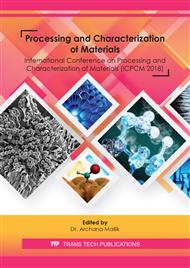p.3
p.12
p.21
p.29
p.34
p.40
p.49
p.55
p.64
Role of Marangoni Convection in a Repetitive Laser Melting Process
Abstract:
To effectively interpret the fluid flow dynamics in the molten metal pool, a numerical model was established. The moving repetitive Gaussian laser pulse is irradiated in the work piece. The consideration of laser scanning speed makes the transport phenomena complex. The continuity and momentum equations are solved to get the flow velocity of the molten metal in the melt pool. The energy equation is solved to know the temperature field in the work piece. The algebraic equations obtained after discretization of the governing equations by Finite Volume Method (FVM) are then solved by the Tri Diagonal Matrix Method. Enthalpy-porosity technique is used to capture the position of the melt front which determines the shape of the melt pool. Marangoni convection is considered to know its effect on the shape of the melt pool. The surface tension coefficient is taken as both positive and negative value while calculating the Marangoni force. The two possible cases will cause the Marangoni force to distort the flow dynamics in the melt pool . It's dominance over the buoyancy force in controlling the melt pool shape is focused in the present study. Further, the present model will present an insight to the consequences of laser scanning velocity over the melt pool dimensions and shape.
Info:
Periodical:
Pages:
34-39
Citation:
Online since:
February 2020
Authors:
Price:
Сopyright:
© 2020 Trans Tech Publications Ltd. All Rights Reserved
Share:
Citation:


